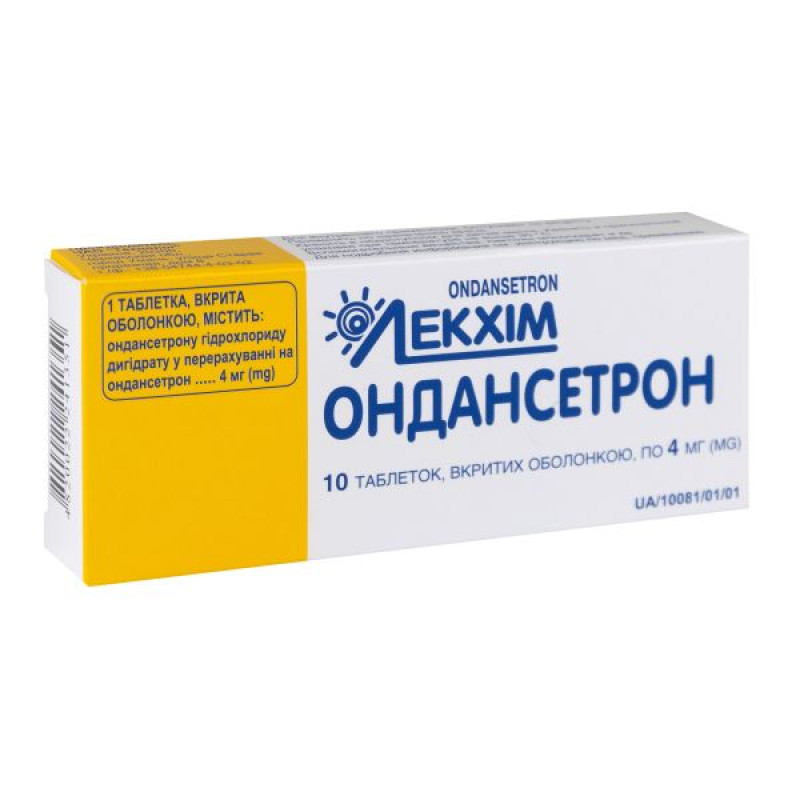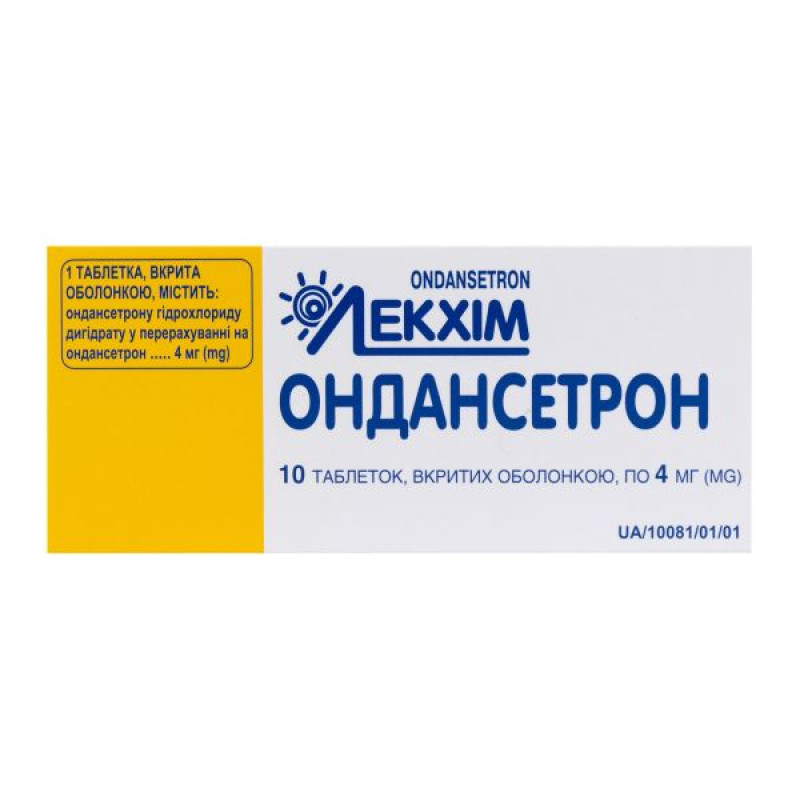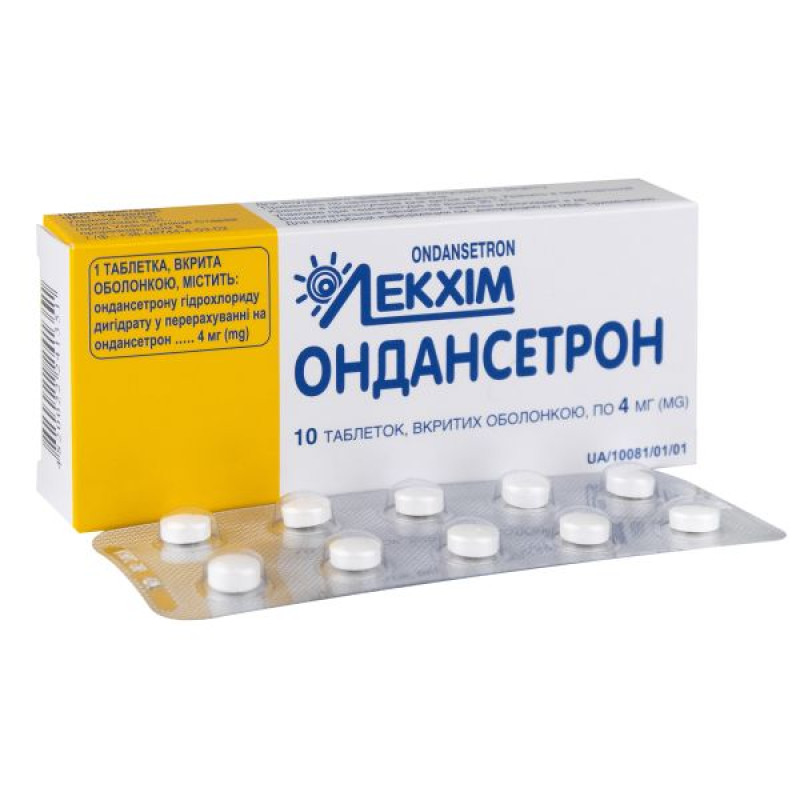Ondansetron film-coated tablets 4 mg blister No. 10

Translation of the instructions can be
Ondansetron film-coated tablets 4 mg, film-coated tablets 8 mgInstruction
For medical use of the medicinal product
Ondansetron
(Ondansetron)
Composition:
Active ingredient: ondansetron;
1 tablet contains ondansetron hydrochloride dihydrate equivalent to ondansetron 4 mg or 8 mg;
Excipients: lactose, microcrystalline cellulose, hypromellose, magnesium stearate, pregelatinized starch, titanium dioxide (E 171), glycerol triacetate.
Dosage form.
The pills are coated.
Main physicochemical properties: white or almost white film-coated tablets, convex on the upper and lower surfaces. When broken, when examined under a magnifying glass, a core surrounded by a single continuous layer is visible.
Pharmacotherapeutic group.
Antiemetics and antinausea drugs. Serotonin 5HT3 receptor antagonists. Ondansetron.
PBX code A04A A01.
Pharmacological properties.
Pharmacodynamics.
Ondansetron hydrochloride is a serotonin 5HT3 receptor antagonist. The mechanisms of its antiemetic action are not fully understood. Radiation and cytotoxic chemotherapy are known to induce the release of serotonin (5HT) from enterochromaffin cells of the small intestine. The initiation of the gag reflex is thought to be mediated by serotonin interaction with 5HT3 receptors located on the afferent endings of the vagus nerve. Activation of the afferent endings of the vagus nerve may result in the release of serotonin into the central nervous system from the chemoreceptor critical zone located in the floor of the fourth ventricle of the brain. Ondansetron is thought to block the initiation of the gag reflex at both the afferent endings of the vagus nerve and the serotonin receptors located in the central nervous system.
Ondansetron has a sedative effect, but does not cause changes in prolactin in the blood plasma, does not reduce the patient's psychomotor activity.
As for the mechanisms of the antiemetic action of ondansetron in the postoperative period, this issue has not been sufficiently studied.
Pharmacokinetics.
The bioavailability of ondansetron after oral administration is 60%. It is actively metabolized in the body, metabolites are excreted in feces and urine. After oral administration, the maximum concentration is reached in one and a half hours. The connection with blood plasma proteins is about 73%. Most of the administered dose is metabolized in the liver.
The half-life is 3-4 hours; in the elderly - up to 6-8 hours. Less than 10% of the active substance is excreted in the urine unchanged.
In vitro studies of ondansetron metabolism indicate that it is a substrate for human hepatic cytochrome P450 enzymes, including CYP1A2, CYP2D6 and CYP3A4. Ondansetron is metabolized predominantly by CYP3A4. Since ondansetron can be metabolized by several cytochrome P450 enzymes, deficiency of one of the enzymes does not significantly alter the total clearance of ondansetron, as the deficiency of one of the enzymes will be compensated for by other enzymes in the metabolism system.
Clinical characteristics.
Indication.
Nausea and vomiting caused by cytotoxic chemotherapy, radiotherapy. Prevention of nausea and vomiting in the postoperative period.
Contraindication.
Hypersensitivity to the components of the drug and to other selective serotonin 5HT3 receptor antagonists.
Severe liver dysfunction, abdominal surgery.
The use of ondansetron together with apomorphine is contraindicated, since cases of severe hypotension and loss of consciousness have been observed with their combined use.
Interaction with other drugs and other types of interactions.
Special studies have shown that ondansetron does not interact with alcohol, temazepam, furosemide, tramadol, or propofol.
Ondansetron is metabolized by various hepatic cytochrome P450 enzymes: CYP3A4, CYP2D6, and CYP1A2.
Due to the diversity of ondansetron metabolism enzymes, inhibition or reduction in the activity of one of them (for example, genetic deficiency of CYP2D6) under normal conditions is compensated by other enzymes and will have no or negligible effect on total creatinine clearance. However, despite the diversity of metabolic enzymes, patients receiving CYP3A4 inducers (i.e. phenytoin, carbamazepine and rifampicin) have shown an increase in the clearance of orally administered ondansetron and a decrease in its plasma concentration.
The following list provides examples of drugs associated with QTc prolongation and/or ventricular flutter/fibrillation (torsade de pointes). Not all of the drugs listed in the pharmacological profile are associated with QTc prolongation and/or torsade de pointes:
class IA, antiarrhythmics (quinidine, procainamide, disopyramide); class III, antiarrhythmics (amiodarone, sotalol, ibutilide, dronedarone); class 1C, antiarrhythmics (flecainide, propafenone); antiemetics (dolasetron, droperidol, chlorpromazine, prochlorperazine); tyrosine kinase inhibitors (vandetanib, sunitinib, nilotinib, lapatinib); antipsychotics (chlorpromazine, pimozide, haloperidol, ziprasidone); antidepressants (citalopram, fluoxetine, venlafaxine, tricyclic/tetracyclic antidepressants such as amitriptyline, imipramine, maprotiline); opioids (methadone); domperidone; macrolide antibiotics and analogues (erythromycin, clarithromycin, telithromycin, tacrolimus); quinolone antibiotics (moxifloxacin, levofloxacin, ciprofloxacin); antimalarials (quinine, chloroquine); azole antifungals (ketoconazole, fluconazole, voriconazole); histone deacetylase inhibitors (vorinostat); β 2 -adrenoceptor agonists (salmeterol, formoterol).Drugs that cause electrolyte imbalance. The concomitant use of ondansetron with drugs that may cause electrolyte imbalance should be avoided. Examples of such drugs include:
loop, thiazide and related diuretics; laxatives and enemas; amphotericin B; high doses of corticosteroids.The above lists of potentially interacting drugs are not exhaustive. Current sources of information should be monitored for new drugs that prolong the QTc interval or cause electrolyte disturbances.
Tramadol: According to a small number of clinical studies, ondansetron may reduce the analgesic effect of tramadol.
Apomorphine: The use of ondansetron with apomorphine hydrochloride is contraindicated as severe hypotension and loss of consciousness have been reported with concomitant use (see Contraindications).
Serotonergic drugs. As with other serotonergic agents, serotonin syndrome, a potentially life-threatening condition, may occur with the use of an antiemetic serotonin 5HT3 receptor antagonist, in combination with other drugs that may affect the serotonergic neurotransmitter system (including triptans, selective serotonin reuptake inhibitors (SSRIs), serotonin-norepinephrine reuptake inhibitors (SNRIs), lithium, sibutramine, fentanyl and its analogues, dextromethorphan, tramadol, tapentadol, meperidine, methadone and pertazocin or St. John's wort (Hypericum perforatum)), as well as with drugs that reduce serotonin metabolism (such as MAO inhibitors, including linezolid (an antibiotic that is a reversible non-selective MAO inhibitor) and methylene blue) (see section "Special instructions").
Application features.
Ondansetron is ineffective in preventing nausea and vomiting during injection.
There is experience of cross-hypersensitivity to different 5HT3 receptor antagonists. Therefore, in the presence of hypersensitivity to one of the 5HT3 receptor antagonists, a similar reaction to other antagonists may be more pronounced due to cross-reactions. In the presence of even a weak hypersensitivity reaction to one of the 5HT3 receptor antagonists, it is not recommended to change it to another, given the possibility of an increase in the hypersensitivity reaction.
Transient ECG changes, including QT prolongation, have been reported rarely with ondansetron, depending on dose and infusion rate. Cases of ventricular fibrillation/flutter (torsade de pointes) have been reported in post-marketing experience with ondansetron, and should be used with caution in patients with or at risk of QT prolongation. Torsade de pointes may be asymptomatic or may present with dizziness, palpitations, syncope, or seizures; this condition may progress to ventricular fibrillation and sudden cardiac death.
Examples of risk factors for the development of ventricular flutter/fibrillation: female gender, age 65 years or older; baseline prolongation of the QT/QTc interval; presence of genetic disorders of cardiac ion channels or regulatory proteins; presence of a family history of sudden cardiac death before the age of 50; heart disease (myocardial ischemia or infarction, left ventricular hypertrophy, cardiomyopathy, conduction system diseases); presence of arrhythmias (especially ventricular arrhythmias, atrial fibrillation); bradycardia (less than 50 beats/min); acute neurological disorders (intracranial or subarachnoid hemorrhage, stroke, intracranial trauma); nutritional imbalance (eating disorders, extreme diets); diabetes mellitus; autonomic neuropathy.
Serotonin syndrome has been described after concomitant use of ondansetron and other serotonergic drugs, including the following symptoms: mental status changes (agitation, hallucinations, coma), autonomic instability (tachycardia, labile blood pressure, hyperthermia), neuromuscular aberrations (hyperreflexia, incoordination), gastrointestinal symptoms (nausea, vomiting, diarrhea). If serotonin syndrome occurs, treatment with ondansetron should be discontinued and symptomatic treatment initiated. If concomitant treatment with ondansetron and other serotonergic drugs is clinically warranted, appropriate monitoring of the patient is recommended (see section "Interaction with other medicinal products and other forms of interaction").
Ondansetron does not affect the cytochrome P450 system, but the use of other drugs that can affect the activity of these enzymes may lead to changes in the clearance and half-life of ondansetron.
Ondansetron increases transit time through the large intestine, so even if there are mild signs of intestinal obstruction, constant monitoring of the patient receiving ondansetron is required.
Children receiving ondansetron with hepatotoxic chemotherapeutic agents should be carefully monitored for possible liver dysfunction.
Since the tablets contain carbohydrates, including lactose, patients with impaired carbohydrate tolerance, with rare hereditary diseases such as galactose intolerance, lactase deficiency or glucose-galactose malabsorption, should not take the drug.
Use during pregnancy or breastfeeding.
Ondansetron should not be used during pregnancy.
It is not known whether ondansetron passes into breast milk, therefore breastfeeding should be discontinued during treatment.
The ability to influence the reaction speed when driving vehicles or other mechanisms.
Given the possibility of developing adverse reactions from the nervous system, patients are advised to refrain from driving or operating other mechanisms during treatment with the drug.
Method of administration and doses.
The drug is to be used internally.
The choice of dosage regimen is determined by the severity of the emetogenic effect of antitumor therapy and is set individually.
Moderately emetogenic chemotherapy and radiation therapy.
Adults: 8 mg 1-2 hours before treatment, followed by 8 mg every 12 hours. For the prevention of delayed or prolonged nausea and vomiting in the following days, 8 mg 2 times a day throughout the entire course of chemotherapy, as well as 5 days after its completion. When choosing a dose, it is necessary to take into account the severity of vomiting. For partial irradiation of the abdominal area with high doses, 8 mg every 8 hours is prescribed.
The drug should be taken throughout the entire course of chemotherapy and radiation therapy, as well as 1-2 days (3-5 days if necessary) after its completion.
Highly emetogenic chemotherapy.
Adults should be given 24 mg of ondansetron orally (simultaneously with dexamethasone phosphate) 1-2 hours before the start of chemotherapy. For the prevention of delayed vomiting in the following days - 8 mg 2 times a day throughout the entire course of chemotherapy, as well as 5 days after its completion.
Children. In this dosage form, the drug should not be used in children under 4 years of age.
Administer ondansetron (solution for injection) as a single intravenous injection immediately before chemotherapy.
Oral administration should be started after 12 hours at 4 mg every subsequent 12 hours and continued for up to 5 days. The total daily dose of ondansetron should not exceed 32 mg.
Postoperative nausea and vomiting.
For adults, to prevent postoperative nausea and vomiting, the drug can be administered orally at a dose of 16 mg 1 hour before the start of anesthesia. The maximum daily dose of ondansetron is 32 mg.
Children. In this indication, it is recommended to use ondansetron in the form of a solution for injection.
For all types of therapy.
Elderly patients
There is no need to change the dose of the drug for patients over 65 years of age.
Patients with renal insufficiency
There is no need to change the dosage regimen or route of administration in patients with renal impairment.
Patients with moderate hepatic impairment
In patients with moderate hepatic impairment, the clearance of ondansetron is significantly reduced and the serum half-life is prolonged. For such patients, the maximum daily dose should not exceed 8 mg.
The half-life of ondansetron in patients with impaired metabolism of sparteine and debrisoquine is not altered. In such patients, repeated administration results in the same drug concentration as in patients with intact metabolism. Therefore, there is no need to change the dosage regimen for this group of patients.
Children.
Do not use this dosage form of the drug for children under 4 years of age.
Overdose.
There is currently little information on overdose with ondansetron. In most cases, the symptoms are similar to those described in patients who were administered the recommended doses.
Symptoms. One patient developed sudden blindness (amaurosis) lasting 2-3 minutes in combination with severe constipation after a single dose of 72 mg ondansetron. Another patient developed hypotension (and loss of consciousness) after taking 48 mg ondansetron. A vasovagal episode with transient second-degree heart block was observed after a 4-minute infusion of 32 mg ondansetron. Neuromuscular disorders, autonomic instability, drowsiness and brief generalized tonic-clonic seizures (resolved after benzodiazepine administration) were observed in a one-year-old child who swallowed 7 or 8 8 mg ondansetron tablets (a dose approximately 40 times higher than the recommended dose for children (0.1-0.15 mg/kg)). In all cases, these phenomena resolved completely.
Treatment: drug withdrawal, symptomatic and supportive therapy. The use of ipecacuanha for the treatment of ondansetron overdose is not recommended, since its effect may not be due to the antiemetic effect of ondansetron. There is no specific antidote.
Further management of patients should be carried out according to clinical indications or, if possible, in accordance with the recommendations of the National Poisons Center.
Ondansetron increases the QT interval in a dose-dependent manner. In case of overdose, ECG monitoring is recommended.
There have been reports of serotonin syndrome in young children following oral overdose.
Adverse reactions.
Adverse reactions, information about which is provided below, are classified by organ and system organ class and by frequency of occurrence: very common (≥1/10), common (≥1/100 and
In clinical studies, the most common adverse reactions were: headache (11%), constipation (4%), feeling hot or flushed (
From the immune system.
Rare: immediate allergic reactions, in some cases severe, including anaphylaxis, bronchospasm, urticaria and angioedema.
From the central nervous system.
Very common: headache.
Uncommon: convulsions, movement disorders (including extrapyramidal reactions such as oculogyric crisis, dystonic reactions and dyskinesia without lasting clinical consequences).
Rare: dizziness during rapid administration of the drug; central nervous system depression, paresthesia.
From the organs of vision.
Rare: transient visual disturbances (clouding of the eyes), transient blindness, mainly during intravenous administration.
From the cardiovascular system.
Uncommon: arrhythmias, pain in the heart area (with or without ST segment depression), bradycardia, hypotension, hypertension, tachycardia, syncope.
Common: feeling of warmth, hot flashes.
On the part of the respiratory system and chest organs.
Uncommon: hiccups, cough.
From the gastrointestinal tract.
Common: constipation, diarrhea, dry mouth, abdominal pain.
On the part of the hepatobiliary system.
Uncommon: asymptomatic elevation of liver function tests, liver dysfunction.
General disorders: weakness, fainting. These cases are observed mainly in patients receiving drugs containing cisplatin.
Metabolism.
Approximately 5% of patients had transient elevations of more than twice the upper limit of normal in SGOT and SGPT. It is not known whether these increases are related to dose or duration of therapy.
Hepatic failure and death have been reported in cancer patients receiving multiple drugs, including potentially hepatotoxic cytotoxic chemotherapy and antibiotics. The etiology of the hepatic failure in these cases remains unclear. There have also been rare reports of hypokalemia.
Adverse reactions from post-marketing surveillance.
The adverse reaction profile in children and adolescents was comparable to that in adults.
From the immune system.
Rare: hypersensitivity reactions, sometimes severe (laryngeal edema, hoarseness, laryngospasm and cardiopulmonary shock/cardiac arrest).
From the cardiovascular system.
Uncommon: myocardial infarction (ST segment elevation), arrhythmias (including ventricular or supraventricular tachycardia, premature ventricular contractions and atrial fibrillation), electrocardiographic changes (including second degree heart block), palpitations and syncope.
Rarely: and predominantly with intravenous use of ondansetron, transient ECG changes, including QT prolongation, cases of ventricular flutter/flicker, ventricular fibrillation, cardiac arrest and sudden death have been reported.
From the organs of vision.
Transient blindness has been reported rarely, usually within the recommended dosage range and predominantly with intravenous administration. In most cases, blindness resolved within 20 minutes.
Asymptomatic elevation of liver function tests.
From the central nervous system.
Transient dizziness (
Not often (
Serotonin syndrome has been reported with the use of 5-HT3 receptor antagonists (including ondansetron hydrochloride) in combination with other serotonergic drugs and/or neuroleptics.
On the skin and subcutaneous tissue.
Very rare: bullous skin and mucous membrane reactions, including fatal ones, including toxic skin eruptions, Stevens-Johnson syndrome and toxic epidermal necrolysis. These reactions have been reported in patients taking other medicines.
Expiration date.
3 years.
Storage conditions.
Store in the original packaging at a temperature not exceeding 30 °C.
Keep out of reach of children.
Packaging.
10 tablets in a blister. 1 blister in a cardboard pack.
Vacation category.
According to the recipe.
Producer.
Ciao "technologist".
Location of production and its address of place of business.
Ukraine, 20300, Cherkasy region, Uman city, Stara Prorizna street, building 8.
There are no reviews for this product.
There are no reviews for this product, be the first to leave your review.
No questions about this product, be the first and ask your question.









